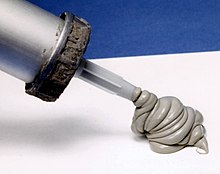Silicone joint
A silicone joint is a flexible joint sealing in the building sector, with sealants of silicone is carried out. These belong to the group of elastomers . They are elastic and have poor electrical conductivity .
elasticity
A joint in the sanitary area is primarily used to compensate movements (e.g. due to vibrations, deformation) between the building materials (e.g. tiles, bathtubs, door frames, etc.) and the penetration of moisture into the joints or the structure to prevent. A distinction is made between elastic and plastic joint material. The elasticity depends on the degree of crosslinking of the respective material. Depending on the area of application, different materials are used, the best known of which are acetate silicone and alkoxy silicone. The word “permanently elastic” is often used for silicone joints , but it is wrong in this context, as silicone also lose their elasticity over time. The influencing factors include UV light , microbiological colonization (such as mold) and cleaning agents and disinfectants . That is why it is better to speak of elastic grouting materials.
Compressibility of silicone
The so-called ZGV value (ZGV = permissible total deformation) indicates the extent to which the silicone sealant can absorb movements. At a value of 20% it means e.g. B. 10% tensile and 10% pressure absorption. With a width of 10 mm, this results in a deformability of ± 1 mm.
Determination of the necessary joint width
The joint width to be selected for individual projects depends on the material properties mentioned above. In the leaflet "Sealing floor joints with elastic sealants", published by the German Sealants Association, the minimum joint widths are specified depending on the temperature difference and the joint spacing. An example: With a joint distance of 6 mm, temperature fluctuations of 40 ° C, and a ZGV of 20%, the minimum joint width is 14 mm. In outdoor areas with a temperature difference of 80 ° C, it is 25 mm in the same case. An overview table is available from the Sealants Industry Association (see web links).
material
Calcareous natural stones like marble Do not allow essigvernetzendem silicone in contact since lime is dissolved in an acid environment. Special silicones are available for use with natural stone. Objects made of tin or brass should not be grouted with acid-curing silicone either, as these metals can be attacked.
Most silicone sealants that come into frequent contact with water are treated with fungicides to slow down mold growth. For the construction of aquariums usually vinegar-curing silicone is used, which however must not contain any fungicide.
processing
When applying, the sealant should not adhere to the base of the joint , the so-called "three-flank adhesion". The sealant should only adhere to the (approximately parallel) opposing surfaces of the components in order to avoid further stresses that may arise from the base of the joint. Ideally, a round cord made of foam or similar material is pushed into the gap before the sealant is applied. This decouples the sealant from the base and creates a watch-glass- shaped profile of the silicone. As a result, the silicone joint in the middle is slim and elastic and widens towards the flank, where good adhesion is important. (According to the IVD data sheet , sealant thicknesses greater than 20 mm should be avoided.)
Prevention of mold
Sanitary silicones are usually treated with fungicides . This means that suitable ingredients reduce microbiological colonization, but not completely prevent it. This effect diminishes over time. Depending on the ambient conditions and the treatment of the sealant ( cleaning agent , moisture , adjacent building materials, etc.), the loss of the fungicidal effect can be accelerated.
Maintenance of silicone joints
After showering and bathing, the joint should be rinsed off and dried with a sponge or cloth. This also removes organic particles that the mold feeds on. Occasionally, the joints should be cleaned with a little cleaning agent and then rinsed and dried again.
In order to delay the appearance of mold, you should ventilate thoroughly after using the bathroom in order to reduce the humidity.
Baths are usually cleaned “acidically”, mostly with cleaning agents that contain acetic acid and, in the professional sector, also phosphoric or amidosulphonic acid . The acids dissolve limescale deposits, but do not prevent mold growth. For this purpose, the joints can be coated with glucoprotamines or quaternary ammonium compounds in order to reduce microbiological colonization. Fruiting bodies of the mold (often visible in the form of black dots) can be killed with sodium hypochlorite. However, even in this case, the mold is still present in the deeper layers of the silicone. The only real renovation option is therefore to renew the joint.
Edge discolouration on natural stones and their removal
When processing silicone and natural stone , there are occasionally unsightly discolorations on the edges of the stone. These have the following causes:
- Some types of silicone are generally not suitable for natural stone. Acetate-curing silicones are used for natural stones containing carbonate such as B. marble is not suitable because it releases acetic acid when it hardens, which attacks the surface and prevents crosslinking with the same. Window silicones contain fatty fillers which can migrate into the natural stone to increase their elasticity at high temperature differences . Such grease stains can often be reduced with a special oil remover paste. These usually consist of a solvent and a carrier. The aim is to dissolve and distribute the oil. The oil is not removed in the process.
- Too much detergent was used for smoothing during processing . One drop in 10 liters of water is usually sufficient. However, plain detergent is often used. Then the active cleaning substances ( tensides ) contained therein migrate into the stone and lead to a "greasy" looking discoloration. With unimpregnated surfaces, it often helps to leave a wet cloth on the affected area for several days. Then the surfactants can slowly spread through the stone and are no longer noticeable.
- On unpolished surfaces, the smoothing of the joints often creates a thin silicone layer, which later creates a “wet effect”. This layer can only be removed mechanically, e.g. B. with a knife and a glass ceramic plane. Such an effect can be avoided with proper masking.
Guidelines
Even with good execution, silicone joints are not waterproof in the long term and must be renewed regularly. Silicone joints are not recognized as permanent seals against the effects of water in the sense of DIN 18534-5 / A1 2018-09 "Sealing of interiors".
- DIN 52460 - "Joints and glass seals - Terms", 12/2015. "Sealing of an intended or tolerance-related component gap with an elastic filler"
- DIN EN 15651 - " Joint sealants for non-load-bearing applications in buildings and pedestrian paths - Part 3: Sealants for joints in sanitary areas", 12/2012
- IVD leaflet no. 3 - 1: “Constructive execution and sealing of joints in sanitary and damp rooms. Part 1: Sealing with sprayable sealants ", 11/2014, Industrieverband Dichtstoffe eV (IVD) - reflects the state of the art .
- IVD Leaflet No. 15: "The maintenance of highly stressed movement-compensating sealants and glued-on elastic joint tapes", 11/2014, Industrieverband Dichtstoffe eV (IVD)
Historical joint sealants
Before the development of permanently elastic joint fillers , there were few options for creating movement joints . If only slight movements were to be absorbed , the joint could be filled with tow made from plant fibers (such as coconut or hemp fibers ), which were impregnated with oil, grease, pitch , wood tar or a rubber mixture to make them water-repellent.
Joints that did not have to absorb movement were often filled with fine mortar, lead or glass putty, which consists of 85% whipping chalk and 15% linseed oil varnish and is kneaded for hours to form a tough dough. By the oxidation of the linseed oil in the air, the hardened putty gradually. Sealant containing linseed oil can cause discoloration if overworked. If a sample of the material is held in a flame, it smells like linseed oil.
See also
Individual evidence
- ↑ Rendl T. - Studies on the result-oriented handling of typical construction defects in residential construction. Grin Verlag, 2009
- ↑ a b c Dr. Sven Bornholdt: Silicone Joints - Correct execution, care and maintenance of elastic joint seals , leaflet tap water damage, July 2018, Institute for Loss Prevention and Loss Research of Public Insurers
- ↑ Jürgen Wendnagel: 5 questions about DIN 18534: Sealing floor and wall surfaces in bathrooms & co. , In: Haustec.de, August 3, 2017 - updated on September 7, 2018

